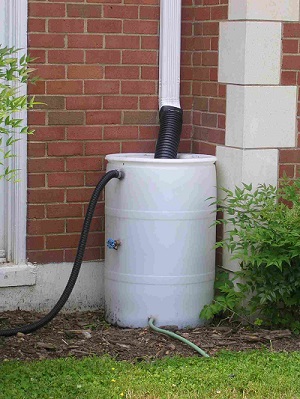Rain Barrel Program Teaches Coastal Residents How to Reduce Stormwater Impacts
 Alabama Current Connection Newsletter, Summer 2017 Vol. XI, Issue1
Alabama Current Connection Newsletter, Summer 2017 Vol. XI, Issue1
By Christian Miller, Watershed Management Coordinator, Mobile Bay National Estuary Program
Coastal Alabama receives more than five feet of rain per year. In urban areas, most of this water washes across hard, or impervious, surfaces, picking up and carrying pollutants into our waterways. The U.S. Environmental Protection Agency considers stormwater runoff to be the greatest threat to water quality in the United States. As more people continue to move to coastal areas, impervious surfaces and, therefore, volume and velocities of stormwater runoff continue to increase.
Rainwater harvesting, the practice of collecting and storing stormwater runoff from roofs and other hard surfaces for future use, is one practical way to reduce impacts associated with residential stormwater runoff. An inch of rain falling on a typical 1,000-square-foot roof yields over 600 gallons of water. Installing a rain barrel at your home is an inexpensive way to capture and store some of this water for later use. With a rain barrel, you'll not only help reduce stormwater runoff, but you'll also have a supply of free, non-chlorinated, soft water for washing your car, watering plants, and many other household uses.
Although rain barrels can be purchased through many retail outlets, they are generally expensive and don’t offer much in the way of education for the consumer. Through an ongoing series of workshops, residents of Mobile and Baldwin counties have been learning how to construct and set up low-cost rain catchment systems at their home, along with other ways to conserve water and protect water quality along the coast. These workshops are continuously scheduled throughout the year, in coordination with partners in both coastal Alabama counties, and last approximately two hours.
The success of the program has been due in large part to the partnerships that have been formed. Local municipalities, including the cities of Daphne, Fairhope, Foley, and Mobile and the Town of Dauphin Island have all hosted rain barrel workshops. “These workshops have been a great help to us on the local level,” said Ashley Campbell, Environmental Programs Manager with the City of Daphne, “They provide an opportunity to inform the public of the issues we are facing related to stormwater management on the coast.”
The Prichard Drainage Study, funded by the MBNEP for Mobile County, and hydrologic modeling by Latif Kalin and Enis Baltaci at Auburn University’s School of Forestry and Wildlife Sciences analyzed conditions in the Toulmins Spring Branch Watershed, a subwatershed of the greater Three Mile Creek Watershed, and examined impacts of stormwater runoff in the Bessemer community of Prichard. These studies recommend the installation of Low Impact Development features, including strategically located rain barrels, as a means of alleviating chronic urban flooding in the area. Follow-up outreach in the community also indicated a strong willingness to receive and use rain barrels at home. Currently, plans are underway to work with partners and homeowners on a pilot project to install approximately 30 rain barrels at homes and local residences around Toulmins Spring Branch. If successful, this project could be expanded throughout the community to significantly reduce the impacts of localized flooding throughout the subwatershed.




